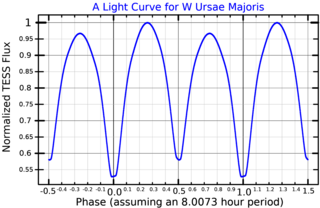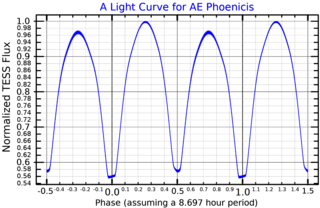
Corvus is a small constellation in the Southern Celestial Hemisphere. Its name means "crow" in Latin. One of the 48 constellations listed by the 2nd-century astronomer Ptolemy, it depicts a raven, a bird associated with stories about the god Apollo, perched on the back of Hydra the water snake. The four brightest stars, Gamma, Delta, Epsilon, and Beta Corvi, form a distinctive quadrilateral in the night sky.

W Ursae Majoris is the variable star designation for a binary star system in the northern constellation of Ursa Major. It has an apparent visual magnitude of about 7.9, which is too faint to be seen with the naked eye. However, it can be viewed with a small telescope. Parallax measurements place it at a distance of roughly 169 light years (52 parsecs) from Earth.
Theta Tucanae is a star in the constellation Tucana.

Psi Centauri, which is Latinized from ψ Centauri, is a binary star system in the southern constellation of Centaurus. It is visible to the naked eye with a baseline apparent visual magnitude of +4.05. The distance to this system is approximately 259 light years based on parallax. The radial velocity is poorly constrained, but it appears to be slowly drifting away from the Sun at the rate of +2 km/s.

S Antliae is a W Ursae Majoris-type eclipsing binary star in Antlia.

EO Aurigae is an eclipsing binary of Algol type in the northern constellation of Auriga. With a combined apparent magnitude of 7.71, it is too faint to be seen with the unaided eye.

YZ Cassiopeiae is a star system 103.8 parsecs (339 ly) away from Earth, in the constellation Cassiopeia. It comprises three stars: an eclipsing Algol-type binary and a visually fainter star about 3000 AU distant.
Epsilon Coronae Australis, is a star system located in the constellation Corona Australis. Varying in brightness between apparent magnitudes of 4.74 to 5 over 14 hours, it is the brightest W Ursae Majoris variable in the night sky.

V831 Centauri is a multiple star system in the constellation Centaurus. It is visible to the naked eye with an apparent visual magnitude that ranges from 4.49 down to 4.66. The system is located at a distance of approximately 380 light years from the Sun based on parallax, and is drifting further away with a radial velocity of +12 km/s. It is a likely member of the Lower Centaurus Crux concentration of the Sco OB2 association of co-moving stars.
Tau9 Eridani is a binary star in the constellation Eridanus. It is visible to the naked eye with an apparent visual magnitude of 4.63. The distance to this system can be estimated using the parallax method, which yields a value of roughly 327 light years.
10 Ursae Majoris is a binary star system in the northern constellation of Lynx. It is visible to the naked eye as a faint star with a combined apparent visual magnitude of 3.960. This system is fairly close to the Sun, at 53 light-years (16.1 pc) away from Earth. It is the third-brightest object in Lynx. Originally in the neighbouring constellation Ursa Major, it became part of Lynx with the official laying down of the constellation borders. The system is moving further from the Earth with a heliocentric radial velocity of 26.4 km/s. It is a probable member of the Hyades supercluster.

Omicron1 Orionis is a binary star in the northeastern corner of the constellation Orion. It is visible to the naked eye with an apparent visual magnitude of 4.7. Based upon an annual parallax shift of 5.01±0.71 mas, it is located approximately 650 light years from the Sun. At that distance, the visual magnitude of the star is diminished by an interstellar absorption factor of 0.27 due to intervening dust.
Chi2 Hydrae, Latinised from χ2 Hydrae, is a binary star system in the equatorial constellation of Hydra. Based upon an annual parallax shift of 4.6 mas as seen from Earth, it is located roughly 710 light years from the Sun. It is visible to the naked eye with a combined apparent visual magnitude of 5.71.

V1191 Cygni is the variable star designation for an overcontact binary star system in the constellation Cygnus. First found to be variable in 1965, it is a W Ursae Majoris variable with a maximum apparent magnitude 10.82. It drops by 0.33 magnitudes during primary eclipses with a period of 0.3134 days, while dropping by 0.29 magnitudes during secondary eclipses. The primary star, which is also the cooler star, appears to have a spectral type of F6V, while the secondary is slightly cooler with a spectral type of G5V. With a mass of 1.29 solar masses and a luminosity of 2.71 solar luminosities, it is slightly more massive and luminous than the sun, while the secondary is only around 1/10 as massive and less than half as luminous. With a separation of 2.20 solar radii, the mass transfer of about 2×10−7 solar masses per year from the secondary to the primary is one of the highest known for a system of its type.

RR Centauri is a variable star of apparent magnitude maximum +7.29. It is located in the constellation of Centaurus, approximately 320 light years distant from the solar system.
HD 163840 is a binary star system in the northern constellation of Hercules. It has a combined apparent visual magnitude of 6.45, which falls just below the brightness level that is visible to the naked eye for people with normal eyesight. An annual parallax shift of 35.40 mas provides a distance estimate of about 92 light years. The system is moving closer to the Sun with a radial velocity of −33 km/s. In about 769,000 years, it will make perihelion at a separation of around 27.2 ly (8.33 pc).

AB Andromedae is a binary star in the constellation Andromeda. Its maximum apparent visual magnitude is 9.49 but shows a variation in brightness down to a magnitude of 10.46 in a periodic cycle of roughly 8 hours. The observed variability is typical of W Ursae Majoris variable stars, so the two stars in this system form a contact binary.

AE Phoenicis is a variable star in the constellation of Phoenix. An eclipsing binary, its apparent magnitude has a maximum of 7.56, dimming to 8.25 during primary eclipse and 8.19 during secondary eclipse. From parallax measurements by the Gaia spacecraft, the system is located at a distance of 168 light-years from Earth.

V752 Centauri is multiple star system and variable star in the constellation of Centaurus. An eclipsing binary, its apparent magnitude has a maximum of 9.10, dimming to 9.66 during primary eclipse and 9.61 during secondary eclipse. Its variability was discovered by Howard Bond in 1970. From parallax measurements by the Gaia spacecraft, the system is located at a distance of 410 light-years from Earth.

TX Ursae Majoris is an eclipsing binary star system in the northern circumpolar constellation of Ursa Major. With a combined apparent visual magnitude of 6.97, the system is too faint to be readily viewed with the naked eye. The pair orbit each other with a period of 3.063 days in a circular orbit, with their orbital plane aligned close to the line of sight from the Earth. During the primary eclipse, the net brightness decreases by 1.74 magnitudes, while the secondary eclipse results in a drop of just 0.07 magnitude. TX UMa is located at a distance of approximately 780 light years from the Sun based on parallax measurements, but is drifting closer with a mean radial velocity of −13 km/s.














